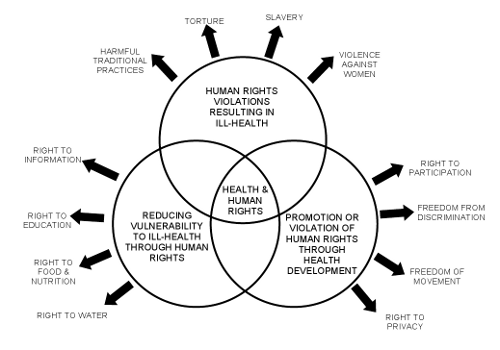Human Right’s Approach to Women’s Right to Health

Shilpa Rani is a third-year undergraduate pursuing law from NUSRL, Ranchi. She believes that having an idea is futile if it is not expressed to the world. She wants to give all her dreams a chance.
Human Right’s Approach to Women’s Right to Health
The exercise as well as enjoyment of all human rights is necessary for full development of a human being. Human Rights and fundamental freedoms help us to develop our intrinsic qualities, intelligence, talents and conscience in order to meet our material and spiritual needs. The knowledge of the rights and freedoms is very important in order to gain the respect for our rights. Right to life is considered one of the fundamental rights, and health is one of the vital indicators reflecting quality of human life. In this context, it becomes one of the primary responsibilities of the state to provide health care services to all its citizens. The patriarchal forces acting in our society are the main reason behind gender inequalities. Hence, one needs to go beyond the biological determinants of health to understand that women’s poor health status is undoubtedly linked with the social and economic inequalities which persist in society and restrict their access to and control over resources. There is a need to analyze and examine the factors which make women vulnerable to mortality, communicable diseases, mental health problems, occupational health hazards and infringes their right to health and well-being. Women’s sexual and reproductive health is related to various human rights like the right to life, the right to be free from torture, the right to health, the right to privacy, the right to education, and the prohibition of discrimination etc.
The Beijing Platform for Action states that “the human rights of women include their right to have control over and decide freely and responsibly on matters related to their sexuality, including sexual and reproductive health, free of coercion, discrimination and violence.”
The human right to health has been recognized by the United Nations (UN) Commission on Human Rights and is incorporated in agreements from intergovernmental world conferences, particularly the 1994 International Conference on Population and Development (ICPD). The right to health and its interpretation also stems from the work of international experts such as the UN committees that oversee the Covenant on Economic, Social and Cultural Rights (CESCR) and the Convention on the Elimination of Discrimination against Women (CEDAW) and the UN Special Reporters on the Right to Health. The right to health includes both health care and other determining factors like access to water and food, freedom from violence, and a healthy environment. Reproductive health is an integral element of the human right to health, meaning thereby that States are under obligations to respect, protect and fulfill rights related to women’s sexual and reproductive health.
Despite these obligations, there are frequent cases of violations of women’s sexual and reproductive health rights. This violation can be in various forms including denial of access to services, required by women only, or poor quality services, subjecting women’s access to services to third party authorization, and performance of certain procedures including forced sterilization, forced virginity examinations, and forced abortion against the their consent. Women’s sexual and reproductive health rights are also at risk when they are subjected to female genital mutilation (FGM) and early marriage. Violations of women’s sexual and reproductive health rights are often deeply enshrined in societal values pertaining to women’s sexuality. Patriarchal concepts of women’s roles within the family are based on their ability to reproduce. Early marriage and pregnancy, or repeated pregnancies as efforts to produce male offspring because of the preference for sons, deteriorates the health of women and sometimes leads to death of many women. Women are also often blamed for infertility, suffering exclusion and being subjected various human rights violations as a result.
Principles of equality and human dignity form the core of all human rights. It is evident in present scenario that women have less access to health services, the reason being their lower status in the family and lack of decision making power regarding ill health, expenditure on health care and non availability of health care facilities prevent them from seeking medical help. One of the main reasons behind this is unequal division of labour that leads to lack of time on women’s side. There exists a sense of ignorance towards health condition of women because of the socially sanctioned ‘feminine’ quality of ‘sacrifice’. Besides, the perceptions of acceptable levels of discomfort for women and men lead to gender differences in willingness to accept that they are sick and seek care. Women wait longer than men to seek medical care for illness. Sometimes it is due to their unwillingness to disrupt household functioning unless they become incapacitated. Relatively high mortality rates of women are a reflection of unequal gender relations, inequalities in resource distribution, lack of access and availability of drugs and health services.
The right to health includes both freedoms and entitlements- ‘Freedoms’ include the right to control one’s health and body (e.g. sexual and reproductive rights) and to be free from interference (e.g. free from torture and from non-consensual medical treatment and experimentation); and ‘Entitlements’ include the right to a system of health protection that gives everyone an equal opportunity to enjoy the highest attainable level of health. Health policies and programs have the ability to either promote or violate human rights, including the right to health, depending on the way they are designed or implemented. Taking steps to respect and protect human rights upholds the health sector’s responsibility to address everyone’s health. A human rights-based approach to health provides strategies and solutions to address and rectify inequalities, discriminatory practices and unjust power relations, which are often at the heart of inequitable health outcomes.


